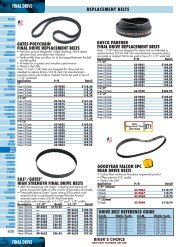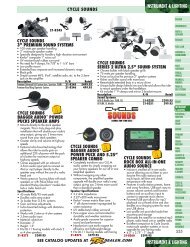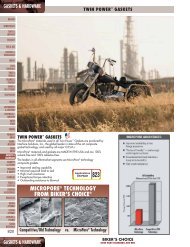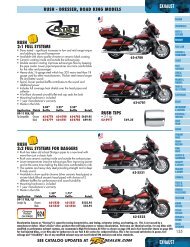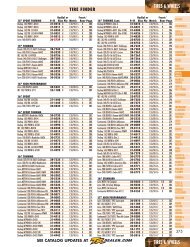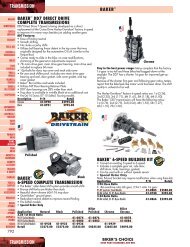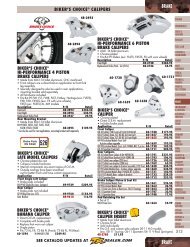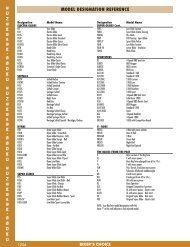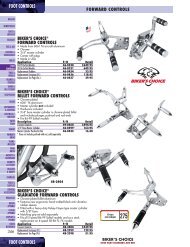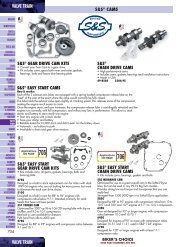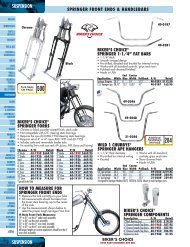Tires & Wheels - Harley-Davidson® Parts and Accessories
Tires & Wheels - Harley-Davidson® Parts and Accessories
Tires & Wheels - Harley-Davidson® Parts and Accessories
Create successful ePaper yourself
Turn your PDF publications into a flip-book with our unique Google optimized e-Paper software.
TIRES & WHEELSTIRE CONVERSION INFORMATIONBAGGERWINDSHIELDSSEATS &LUGGAGEEXHAUSTFUEL & AIRCONTROL &HANDLEBARSCABLESFOOTCONTROLSTIRES &WHEELSFRAMES &FENDERSTANKS &OIL SYSTEMSSUSPENSIONBRAKEINSTRUMENT& LIGHTINGELECTRICAL/IGNITIONVALVETRAINENGINEPRIMARYDRIVETRANS-MISSIONFINALDRIVEGASKETS &HARDWARESECURITY& COVERSTRAILERS& RAMPSASPECT RATIOThe aspect ratio of a tire is the relationship of the tire cross sectionheight to the cross-section width. In a tire with an aspect ratio of 85,for example, height is about 85% of the tire width. “Low profile”tires have an aspect ratio of less than 80. The aspect ratio of a tire isoften contained in the size marking,e.g., 130/90 x 16, etc.TIRE SIZE MARKINGSMotorcycle tires are manufactured in a number of different countrieswith differing requirements in terms of load, dimensions <strong>and</strong> speedratings. This has resulted in various size markings. The followingcharts give a guide to the relationship between various size markings.THESE CHARTS DO NOT IMPLY EXACT COMPARISONS.SPEED RATINGS (SUSTAINED SPEED)Tire manufacturers do not recommend the use of their products in excess of legalspeed limits.R = 106 mphS = 112 mphT = 118 mphH = 130 mphV = 150 mphW = 168 mphZ = 150 + (Contact Manufacturer)STREET MOTORCYCLETIRE SIZE CONVERSION CHARTFront <strong>Tires</strong>Rear <strong>Tires</strong>Metric Alpha Inch Metric Alpha Inch80/90 MH 2.50/2.75 110/90 MP85 4.00/4.2590/90 MJ90 2.75/3.00 120/90 MR90 4.50/4.75100/90 MM90 3.25/3.50 130/80 5.00/5.10110/90 MN90 3.75/4.00 130/90 MT90 5.00/5.10120/80 4.25/4.50 140/80 5.50/6.00120/90 MR90 4.25/4.50 140/90 MU90 5.50/6.00130/90 MT90 5.00/5.10 150/80 MV85 6.00/6.25150/90 MB85 6.00/6.25WARNING: Dealers: Convey this important information to customers<strong>and</strong> tire fitters: The above are size marking conversion charts only <strong>and</strong>do not imply the ability to interchange sizes. Consult motorcyclemanufacturer for correct replacements for original equipment tires.Critical clearances, motorcycle compatibility <strong>and</strong> stability, load bearingcapacity, speed rating, radial versus non-radial, pattern <strong>and</strong> treadcompound requirements, inflation recommendations, <strong>and</strong> front to rearmatching will all vary with tire selection. Wrong selection can result intire failure, loss of control with serious injury or death.Abbreviations used in this section:B - BeltedBlk - BlackBW - BlackwallNWW - Narrow White WallOWL - Outlined White LettersPr - Ply ratingRBL - Raised Black LettersRWL - Raised White LettersSW - Slim WhitewallTL - TubelessTT - Tube TypeWW - White WallWWW - Wide White WallIMPORTANT SAFETY INFORMATION:DEALERS CONVEY THE FOLLOWING TO CUSTOMERSAND TIRE FITTERS:1. Follow Tire Mounting Safety Precautions as specified by the tiremanufacturer.2. Checking of tire pressures is the most important tire-maintenancefunction you <strong>and</strong> your customer may perform. NOTE: For highspeed,fully loaded or dual-riding touring motorcycle applications,inflate front tires to maximum recommended by vehicle manufacturerfor Dunlop fitment <strong>and</strong> rear tires to maximum load inflation pressureon sidewall. Rear touring tires must be inflated to a minimum of 36psi for light to medium loads <strong>and</strong> 40 psi for dual riding <strong>and</strong> otherloads. Never exceed maximum load indicated on tire sidewall, orvehicle capacity load found in owner’s manual.3. Replacements for worn, differently patterned or constructed tires willnot react the same. When new tires are fitted, they should not besubjected to maximum power, abrupt lean-over or hard corneringuntil a reasonable run-in distance of approximately 100 miles hasbeen covered. This will permit the rider to become accustomed to thefeel of the new tires or tire combination, find the edge, <strong>and</strong> achieveoptimum road grip for a range of speed, acceleration <strong>and</strong> h<strong>and</strong>linguse. Advise your customer to check <strong>and</strong> adjust to recommendedinflation pressure after tire cools for at least three (3) hours followingrun-in. Remember: New tires will have a very different contact patch<strong>and</strong> lean-over edge. New tires, new with older, as well as differentpattern combinations require careful ride evaluation.4. The letters S, H, V <strong>and</strong> Z included in the size markings of some of ourstreet tires are speed ratings recognized by the European Tire <strong>and</strong> RimOrganization <strong>and</strong> Japanese Industry St<strong>and</strong>ards. The ratings areassigned based upon controlled indoor wheel testing. Dunlop does notrecommend the use of any of its products in excess of legal speed limits.5. For purposes of assessing clearance, inflated section width is not thetread width. Section width is the width of the tire measured fromsidewall to sidewall at the widest point in the case of most tires.The exceptions are in some of the knobby tires where the knobs onthe sidewall protrude farther than the section width.6. Metric-sized sport tires do not have the same load capacity asalpha-numeric (i.e., MT90H16) touring tires <strong>and</strong> should not beused for the same service.CHEMICALTOOLS &SUPPLIESGENERALACCESSORIESHEADGEARRIDINGAPPARELCASUALAPPARELDISPLAY &PROMOCROSSREFERENCE378TIRES & WHEELSBIKER’S CHOICENEW PART NUMBERS ARE RED



